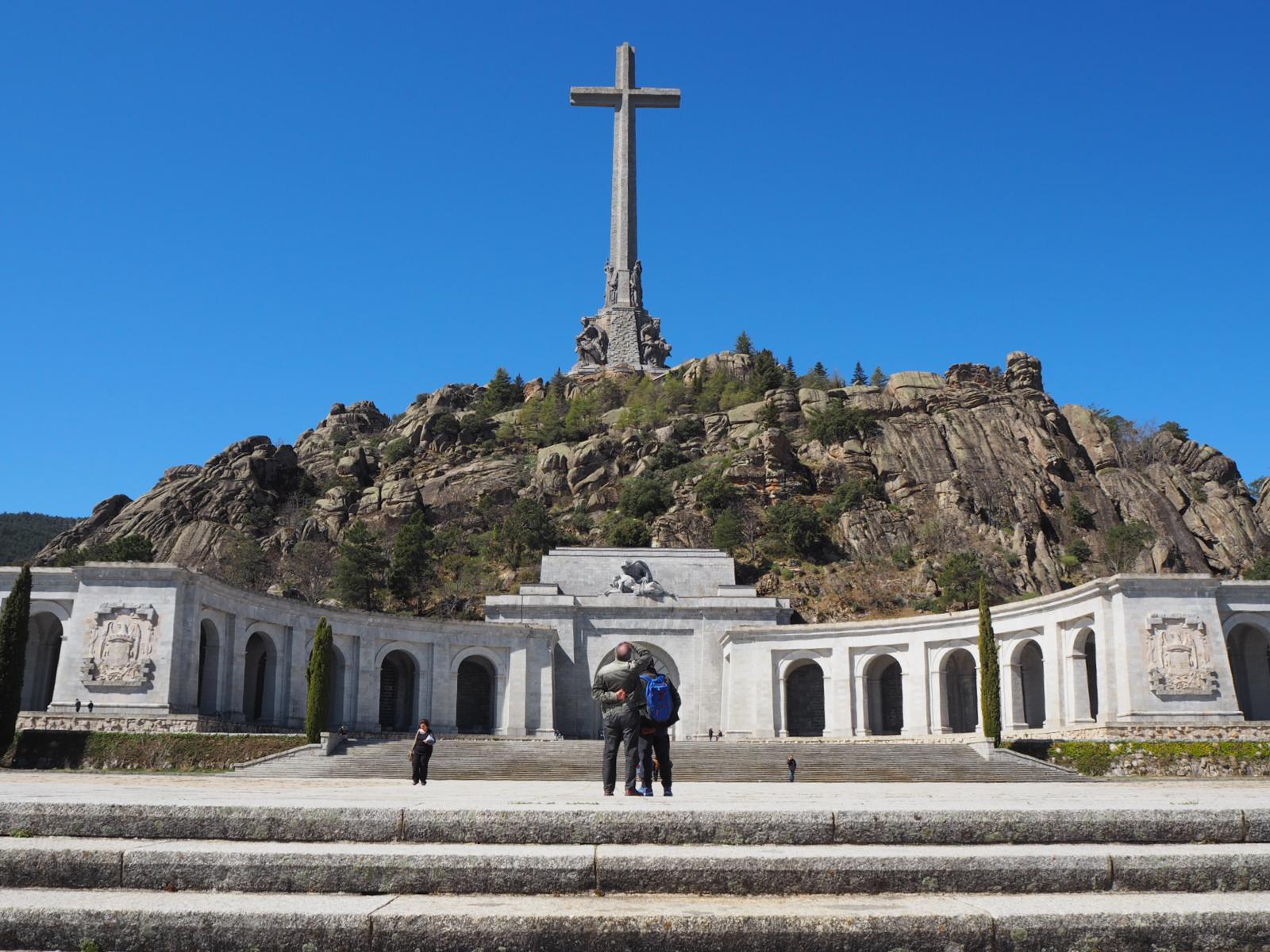The man has come from the Canary Islands, accompanied by his cousin, because he's "very excited" to visit the Valle de los Caídos, the "Valley of the Fallen" near Madrid. Buried there is the man he calls "Don Francisco": Francisco Franco, dictator of Spain from 1939 to 1975. He has an almost moral duty to see him before they can remove his remains. Like it or not, he argues, it's "our history". He says he's "always" respected him, the dictator that is, and always will. Franco's got a privileged spot, in the centre of the basilica, next to the founder of his Falange party, José Antonio Primo de Rivera. The 33,000 victims of the Spanish Civil War buried there, victims from both sides, don't have the same luck. But the visitor doesn't believe the dictator should be moved from there, as far as he's concerned everything's in order:
"He's fine here, alongside the bad people..."
"The bad people?"
"I mean, the republicans, the Reds".
It's a Wednesday morning, a working day, but nonetheless there are dozens of people here. Like every day, there's a mass at eleven. It's not like the homage to the dictator on 20th November every year, the anniversary of his death, but the priest does pray for the "fate of Spain" and for the "blessed martyrs whose relics we watch over". The dark in the basilica means you can't take in the blood-stained walls, built by the forced labour of thousands of political prisoners, some of whom died on this very site. On Franco's tomb there are about fifteen fresh flowers. The silence and solemnity are sepulchral.
Among the earliest risers are a group of French secondary school students who've come by coach. Their lycée organises a regular trip to Madrid, but this is the first time they've come to the majestic Valle de los Caídos. Their teacher clarifies that they know who's buried there, and that that's precisely the reason they've come as part of their history programme. They're not wasting the chance: there are few mausoleums for dictators in the rest of Europe. The other visitors are all tourists or people nostalgic for those days, be it openly or not. They practically all use the language of "opening wounds" and "stirring up history".
The dark in the basilica means you can't take in the blood-stained walls, built by the forced labour of thousands of political prisoners
There's a Catalan from Vallromanes who you'd probably put in that group of those hiding nostalgia. He explains he's come with his wife because "it's history", and that afterwards they're going to visit El Escorial, a monastery and former palace that's the burial site of many Spanish monarchs. But when he's asked about the exhumation of the dictator, set in motion by Pedro Sánchez's government and which is expected to finally take place on 10th June, he dodges the issue: "We're not interested in politics in the slightest," he says. He goes on: "I see it as a fuss. There are other things to do before that... But, I've already told you, politics for me...".
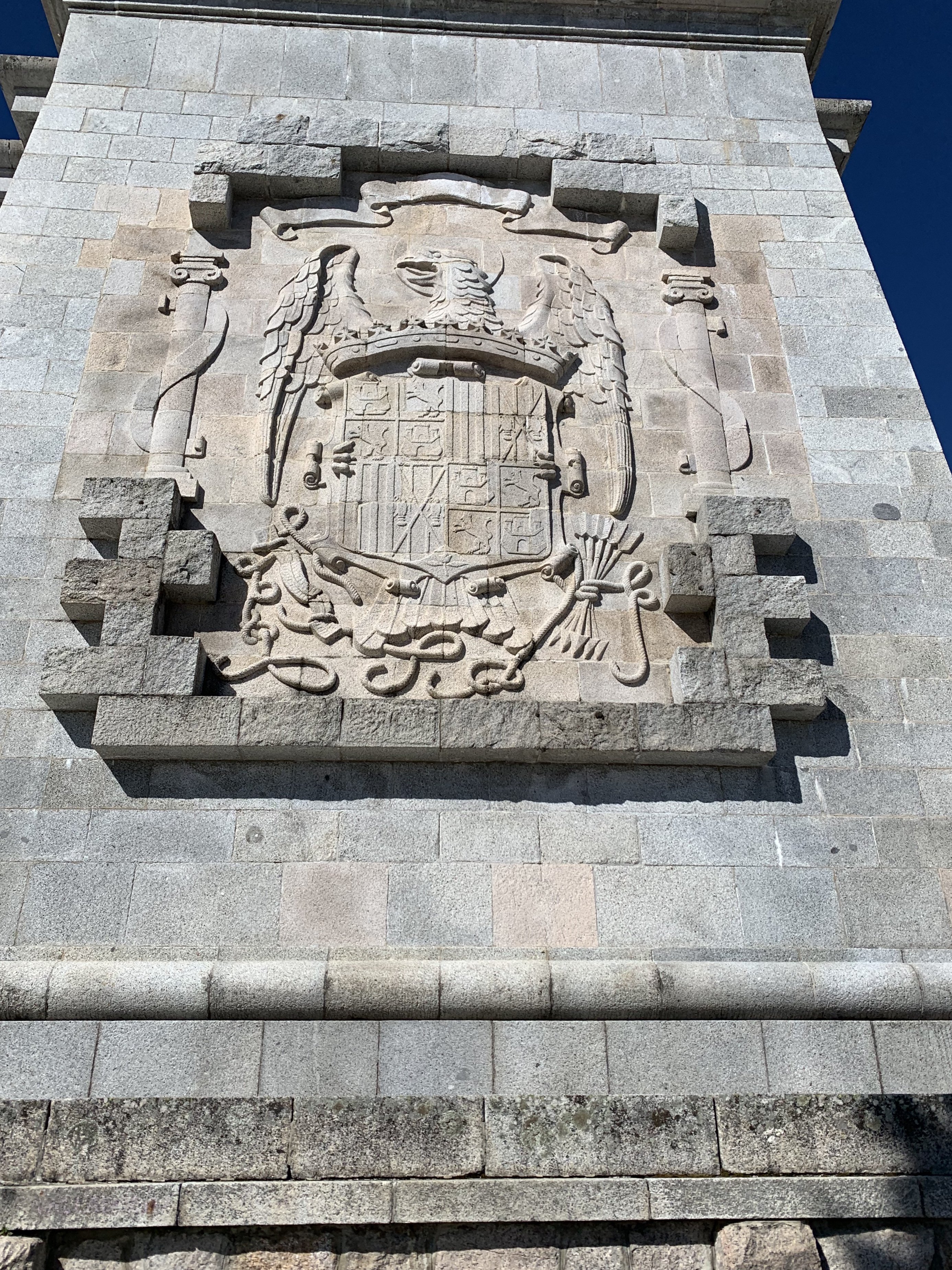
Francoist symbols on the front of the Valle de los Caídos basilica. Photo: Nicolas Tomás
A woman from Jerez de la Frontera, accompanying three others from Madrid, Mexico and Poland (who all look like missionaries), also says it doesn't matter where he's buried. "Franco will probably be in heaven, but I don't care much about his body," she says. That said, she opposes his exhumation. She thinks it's a "smokescreen" from PSOE, who she accuses of "wanting to remember the horrible war" every day. "Why do we have to quarrel with each other now? What will they take away? A couple of bones? Haven't we learnt to live in peace?," she asks. She has her own suggestion for prime minister Pedro Sánchez: "Take him to the Moncloa [government palace]. It would be the best place".
Among the other visitors who've come to "see the Generalísimo" are two friends from Vitoria (Basque Country) who break the pattern. They've come for the monument itself and what it signifies. They think the exhumation is great and even say it should have happened a long time ago. "It's incomprehensible that an homage to the dictator who crushed freedoms should have lasted so long," one of them says. "The Valle de los Caídos is to piss on the victims, burying them with the executioner," he says. They are fascinated by the monumental, 150-metre-high cross which crowns the complex, visible for literal miles.
The Valle de los Caídos is, at its heart, a story of victims and executioners, of the winners and losers from the 1936 military coup. El Nacional now wants to answer the question: why is the dictator still lying with his victims more than 40 years after his death?
The voice of the victims
Despite his modesty, the story of Nicolás Sánchez Albornoz (Madrid, 1926) is almost heroic, it was literally made into a movie. He's a survivor of the Valle de Cuelgamuros, as the Valle de los Caídos used to be known, which he was sent to as a political prisoner and from where he escaped by whatever means he could. He's not been back since because he hasn't wanted to. And he doesn't plan to change his mind once the dictator's body has been taken away. "There are prettier places to visit in the world," he says. For that reason, he welcomes us into his home, close to Madrid's Retiro park.
At 93, he still speaks lucidly and fervently. Before anything, he wants to clarify something when he hears the name "Valle de los Caídos". He'll always call it Cuelgamuros, its original name. "'Valle de los Caídos' is a later invention to make the Americans happy, but we have no reason to join in that game," he says. He arrived at Cuelgamuros sentenced to forced labour for having tried to clandestinely rebuild the Federación Universitaria Escolar (a students' union involved in protests against the Primo de Rivera dictatorship). He escaped after a few months and went first to Paris, then to Argentina, where he lived in exile for decades.
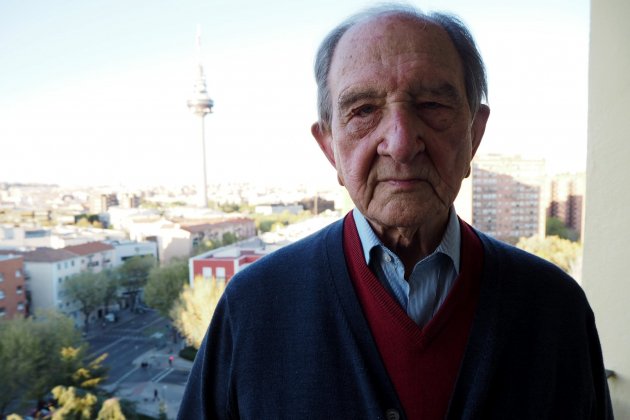
Nicolás Sánchez Albornoz, prisoner who escaped the Valle de los Caídos, receives El Nacional at his home. Photo: Nicolas Tomás
In his role as a historian, he prefers to not make his own experience too dramatic or epic. "They want you to break into a flood of tears when they interview you, but there's no need," he says. In fact, he says he felt no fear at that time; that only came when he read the novel written by Manuel Lamana, his escape partner (Otros hombres, literally "Other Men", apparently never published in English). It was then that he realised the grandeur of the feat they'd achieved.
"They want you to break into a flood of tears when they interview you, but there's no need"
For Sánchez Albornoz, Franco's exhumation is a minimal step before redefining what Cuelgamuros represents. The dictator cannot remain alongside his victims, in any circumstances. But he believes that the Spanish government has been too generous with the Franco family: "As a state, it's got sufficient legal resources to take decisions without consulting anyone," he says. In response to one of the common counter-arguments, he says: "all that about respecting individuals seems good to me, but [...] he's a terrible dictator".
He also attacks the family's obstructionist strategy, trying to block the exhumation through the courts. "You can't be more humanitarian than burying him alongside his beloved wife. It's as if they were burying him next to an animal!" he exclaims. And he criticises the "disastrous" role played by the Church, which "has been messing it up constantly".
What to do then with Cuelgamuros? He's not got a clear answer to that. First things first, due to the complexities inherent in giving it new meaning: it was built by the forced labour of political prisoners. He suggests one possibility: stopping putting public money into it. "It's costing the state a lot of money and it's deteriorating," he says. "The first step has to be to not give it another penny. It could end up falling through actions of wise nature? There's no problem there. Other empires, like Rome, have fallen and today people walk among their ruins".
In terms of "historical memory", he regrets there's much still to be done. "So far, no government has done enough," he says. Only two came close for him, first Zapatero with his 2007 law of historical memory, despite it being "insufficient", and secondly the current Sánchez government, which has started the exhumation process.
The voice of the executioners
General Juan Chicharro, former adjutant to king emeritus Juan Carlos I, and cousin of the secretary general of far-right party Vox, Javier Ortega Smith, receives El Nacional at the headquarters of the National Francisco Franco Foundation. It's a stone's throw from Real Madrid's Santiago Bernabéu stadium, in the well-off barrio of Chamartín. He's the organisation's president. And its name is what it looks like. His office is dominated by two large portraits of the Caudillo and various Spanish flags (Franco era, of course, and even a Carlist one). On his desk, a pile of biographies of the dictator and a membership card for an association of the Blue Division, the Spanish volunteers and conscripts who fought for Hitler against the Soviet Union.
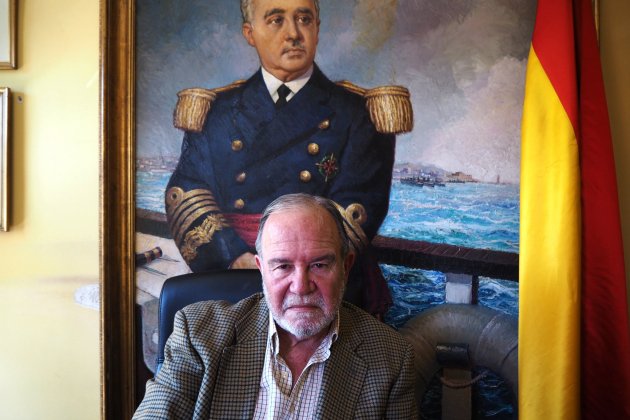
General Chicharro, president of the National Francisco Franco Foundation. Photo: Nicolas Tomás
His version of the story of the Valle de los Caídos is idiosyncratic. The prisoners who worked there did so voluntarily and under "extraordinary" work conditions, he says. "They went there with their families, they earned a wage and had their sentence reduced by one day for every five they were there. To the extent that people sentenced to death were back in the streets within five years," he claims. "I'm not saying the political prisoners were fighting to go there, but they preferred to go there over being in other places". There were officially fifteen deaths linked to the construction, a much disputed figure.
Despite admitting that Franco didn't say he wanted to be buried there, that it "was the king who buried him there", Chicharro unequivocally opposes his exhumation. "It's an order from the Congress, but there are the courts," he says. He gives a hypothetical example: "Congress could say we're all black. But then the courts, in accordance with the law, will say 'no, we're not blacks in Spain, we're whites, yellows and coloureds'. Otherwise Spain would be a dictatorship".
And it's in the courts, the Supreme Court to be exact, he's placed his hopes. They've applied for a provisional suspension to the exhumation. The former king's former adjutant has no qualms admitting there's been a concerted strategy among the dictator's circles to present identical appeals to different courts. Moreover, he says, it's worked: "We're nobody and we've stopped the state".
"I'm not saying the political prisoners were fighting to go there, but they preferred to go there over being in other places"
El Nacional interviewed Chicharro before last month's Spanish general election. Beyond the Supreme Court, he'd hoped that a change of government in favour of the right wing would be able to stop it. "In terms of [Vox's] Santiago Abascal, it's clear that he completely opposes the law on historical memory", he said, "[and in terms of] Ciudadanos it's very clear: he could be removed from there". The unknown is Pablo Casado's PP: "We'll see where they get, but I don't have a lot of faith. Dolors Montserrat replied to us in writing that they would appeal the exhumation order and in the end they didn't".
In short, he believes that "history is what it is and you shouldn't try to change it". Finally, returning to the question of the two Falangists lying in places of honour, he's got a clear answer: "it was Franco who built the basilica".
Removing the dictator, the first step
Shortly after he became prime minister, Pedro Sánchez and his government got underway on the process to exhume Franco with an order on 24th August last year. After giving the family months to do something with their relative's remains, on 15th March this year, they brought it to a conclusion. If the Supreme Court doesn't stop it, his remains will be removed on 10th June and taken to the Mingorrubio-El Pardo cemetery in Madrid, to lie alongside his wife Carmen Polo.
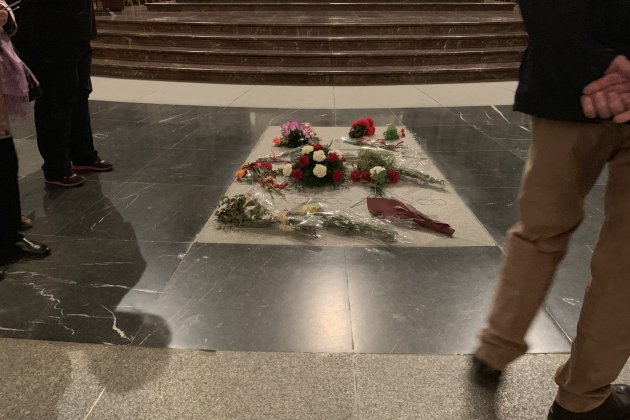
Francisco Franco's tomb at the heart of the Valle de los Caídos. Photo: Nicolas Tomás
Miguel Ángel Muga, lawyer and president of the Forum for the Memory of Madrid, believes that the Spanish government has been very concerned about protecting rights, perhaps too much so. He notes that German authorities agreed with the family of Rudolf Hess to scatter his ashes in the sea. He believes that Sánchez should have taken a stronger stance, for example with the judge who admitted one of the challenges from Franco's circles. "As well as recusing him, the government should have presented a lawsuit for malfeasance in office," he says. The lawyer says no provisional suspension can be applied because the exhumation is reversible.
But beyond exhuming the dictator, Muga believes there are other things that need doing. Firstly, "removing Francoism from the institutions", meaning the narrative of "reconciliation" giving victims and their executioners on the same status. Secondly, solving the other "problems" of the Valle de los Caídos, like removing José Antonio Primo de Rivera, expelling the Benedictine community from the basilica, removing the "national-Catholic" cross and explaining the site's true history to visitors. Anything else is not "giving it new meaning". He thinks it should also be checked whether it's possible to recover any of the 33,000 bodies documented there.
The problem, for the lawyer, runs deep: the law on historical memory was insufficient and even counter-productive. He summarises it: "there's no true, there's no compensation, there's no justice". And that's what reality shows: it's been ignored by right-wing government, for example when it comes to streets named for Franco-era figures. A great flaw, according to Muga, is the lack of deadlines, sanctions or possible legal consequences for not meeting the law's requirements. When it comes to the Valle de los Caídos, the law bans political events from being held there, "but every 20th November they hold a mass where they praise José Antonio and the dictator. That's more than praying to God", he says.
El Nacional contacted the lawyer who represents the Franco family, Luis Felipe Utrera Molina. After an exchange of messages with his office, he refused our request for an interview.

